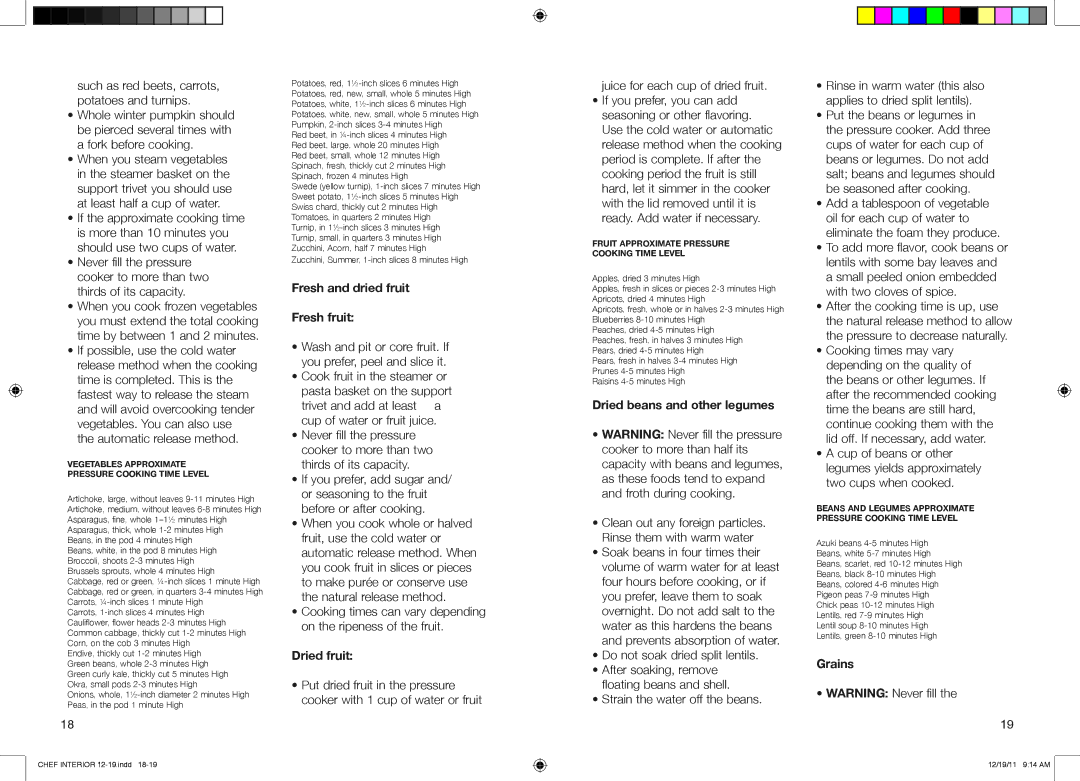such as red beets, carrots, potatoes and turnips.
•Whole winter pumpkin should be pierced several times with a fork before cooking.
•When you steam vegetables in the steamer basket on the support trivet you should use at least half a cup of water.
•If the approximate cooking time is more than 10 minutes you should use two cups of water.
•Never fill the pressure cooker to more than two thirds of its capacity.
•When you cook frozen vegetables you must extend the total cooking time by between 1 and 2 minutes.
•If possible, use the cold water release method when the cooking time is completed. This is the fastest way to release the steam and will avoid overcooking tender vegetables. You can also use the automatic release method.
VEGETABLES APPROXIMATE
PRESSURE COOKING TIME LEVEL
Artichoke, large, without leaves 9-11 minutes High Artichoke, medium, without leaves 6-8 minutes High Asparagus, fine, whole 1–1½ minutes High Asparagus, thick, whole 1-2 minutes High
Beans, in the pod 4 minutes High Beans, white, in the pod 8 minutes High Broccoli, shoots 2-3 minutes High Brussels sprouts, whole 4 minutes High
Cabbage, red or green, ¼-inch slices 1 minute High Cabbage, red or green, in quarters 3-4 minutes High Carrots, ¼-inch slices 1 minute High
Carrots, 1-inch slices 4 minutes High Cauliflower, flower heads 2-3 minutes High Common cabbage, thickly cut 1-2 minutes High Corn, on the cob 3 minutes High
Endive, thickly cut 1-2 minutes High Green beans, whole 2-3 minutes High Green curly kale, thickly cut 5 minutes High Okra, small pods 2-3 minutes High
Onions, whole, 1½-inch diameter 2 minutes High Peas, in the pod 1 minute High
18
Potatoes, red, 1½-inch slices 6 minutes High Potatoes, red, new, small, whole 5 minutes High Potatoes, white, 1½-inch slices 6 minutes High Potatoes, white, new, small, whole 5 minutes High Pumpkin, 2-inch slices 3-4 minutes High
Red beet, in ¼-inch slices 4 minutes High Red beet, large, whole 20 minutes High Red beet, small, whole 12 minutes High Spinach, fresh, thickly cut 2 minutes High Spinach, frozen 4 minutes High
Swede (yellow turnip), 1-inch slices 7 minutes High Sweet potato, 1½-inch slices 5 minutes High Swiss chard, thickly cut 2 minutes High Tomatoes, in quarters 2 minutes High
Turnip, in 1½-inch slices 3 minutes High Turnip, small, in quarters 3 minutes High Zucchini, Acorn, half 7 minutes High
Zucchini, Summer, 1-inch slices 8 minutes High
Fresh and dried fruit
Fresh fruit:
•Wash and pit or core fruit. If you prefer, peel and slice it.
•Cook fruit in the steamer or pasta basket on the support trivet and add at least ½ a cup of water or fruit juice.
•Never fill the pressure cooker to more than two thirds of its capacity.
•If you prefer, add sugar and/ or seasoning to the fruit before or after cooking.
•When you cook whole or halved fruit, use the cold water or automatic release method. When you cook fruit in slices or pieces to make purée or conserve use the natural release method.
•Cooking times can vary depending on the ripeness of the fruit.
Dried fruit:
•Put dried fruit in the pressure cooker with 1 cup of water or fruit
juice for each cup of dried fruit.
•If you prefer, you can add seasoning or other flavoring. Use the cold water or automatic release method when the cooking period is complete. If after the cooking period the fruit is still hard, let it simmer in the cooker with the lid removed until it is ready. Add water if necessary.
FRUIT APPROXIMATE PRESSURE
COOKING TIME LEVEL
Apples, dried 3 minutes High
Apples, fresh in slices or pieces 2-3 minutes High Apricots, dried 4 minutes High
Apricots, fresh, whole or in halves 2-3 minutes High Blueberries 8-10 minutes High
Peaches, dried 4-5 minutes High Peaches, fresh, in halves 3 minutes High Pears, dried 4-5 minutes High
Pears, fresh in halves 3-4 minutes High Prunes 4-5 minutes High
Raisins 4-5 minutes High
Dried beans and other legumes
•WARNING: Never fill the pressure cooker to more than half its capacity with beans and legumes, as these foods tend to expand and froth during cooking.
•Clean out any foreign particles.
Rinse them with warm water
•Soak beans in four times their volume of warm water for at least four hours before cooking, or if you prefer, leave them to soak overnight. Do not add salt to the water as this hardens the beans and prevents absorption of water.
•Do not soak dried split lentils.
•After soaking, remove floating beans and shell.
•Strain the water off the beans.
•Rinse in warm water (this also applies to dried split lentils).
•Put the beans or legumes in the pressure cooker. Add three cups of water for each cup of beans or legumes. Do not add salt; beans and legumes should be seasoned after cooking.
•Add a tablespoon of vegetable oil for each cup of water to eliminate the foam they produce.
•To add more flavor, cook beans or lentils with some bay leaves and a small peeled onion embedded with two cloves of spice.
•After the cooking time is up, use the natural release method to allow the pressure to decrease naturally.
•Cooking times may vary depending on the quality of the beans or other legumes. If after the recommended cooking time the beans are still hard, continue cooking them with the lid off. If necessary, add water.
•A cup of beans or other legumes yields approximately two cups when cooked.
BEANS AND LEGUMES APPROXIMATE PRESSURE COOKING TIME LEVEL
Azuki beans 4-5 minutes High
Beans, white 5-7 minutes High
Beans, scarlet, red 10-12 minutes High
Beans, black 8-10 minutes High
Beans, colored 4-6 minutes High
Pigeon peas 7-9 minutes High
Chick peas 10-12 minutes High
Lentils, red 7-9 minutes High
Lentil soup 8-10 minutes High
Lentils, green 8-10 minutes High
Grains
•WARNING: Never fill the
19

